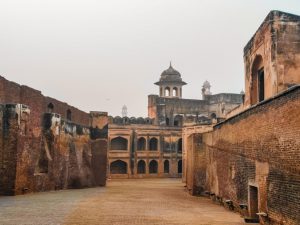
Amluk Dara Stupa, Hungarian-British Archaeologist
October 26, 2021
The Ultimate Hunza Valley Travel Guide for 2025
April 25, 2025 If you are a Pakistani citizen you must have visited the Lahore Fort or heard about the Lahore Fort. But people don’t know the secret stories behind the great Lahore Fort. It’s not just a huge building but has a vast history associated with it. The fort had existed at least since the 11th century but was completely rebuilt by various Mughal Emperors. According to historic accounts, the fort was destroyed by Mongols in 1241 AD, and later on, it was rebuilt by Sultan Ghiyas ud din Balban in 1267 AD. In 1398 it was again destroyed by Amir’s Tamir troops. In 1421 AD Sultan Mubarak Shah Syed, the second monarch of the Sayyid Dynasty rebuilt the fort in the mud. In 1432 AD the fort was captured by Sheikh Ali of Kabul further made repairs to the damaged fort. In 1544 AD by Mughal Emperor Akbar rebuilt the mud fort with solid brick masonry on its earlier foundations.
If you are a Pakistani citizen you must have visited the Lahore Fort or heard about the Lahore Fort. But people don’t know the secret stories behind the great Lahore Fort. It’s not just a huge building but has a vast history associated with it. The fort had existed at least since the 11th century but was completely rebuilt by various Mughal Emperors. According to historic accounts, the fort was destroyed by Mongols in 1241 AD, and later on, it was rebuilt by Sultan Ghiyas ud din Balban in 1267 AD. In 1398 it was again destroyed by Amir’s Tamir troops. In 1421 AD Sultan Mubarak Shah Syed, the second monarch of the Sayyid Dynasty rebuilt the fort in the mud. In 1432 AD the fort was captured by Sheikh Ali of Kabul further made repairs to the damaged fort. In 1544 AD by Mughal Emperor Akbar rebuilt the mud fort with solid brick masonry on its earlier foundations.
The fort does not look the same as it was in 1566 because the Mughal emperor after Shah Jahan, Maharaja Ranjit Singh, ruler of the Sikh Empire, and British colonizers made various variations in the fort but it is still as magnificent as it was in the Mughal period. During the British Rule Diwan e Aam was turned into a hospital and dispensary. The royal kitchen was turned into a prison cell. The chamber of Emperor Jahangir turned into the dining hall and the haram was converted into guest houses. The Britishers built their kitchens on the rooftop of Diwan e Aam.
The Moti Masjid that was converted into Moti Mandir by Maharaja Ranjit Singh during his rule was restored to its former status in 1899. In 1927 A.D. The British handed over the Fort to the Department of Archaeology and later after 1947, it became part of Pakistan.
There are 21 buildings within the fort that house the kings of that era. The grand fort has two main gates, Masjidi gate, built by Mughal Emperor Akbar and the second gate is Alamgiri gate, built by Mughal Emperor Aurangzeb. Currently, the Alamgiri gate has been used as an entrance gate. The Musamam gate was built by Emperor Shah Jahan for his ease later on Emperor Aurangzeb built another gate known as the Alamgiri gate which is accessed through the Hazoori Bagh. Shah Burj gate is the main entrance of the fort built by Emperor Shah Jahan in 1631-32.
When you enter the fort, the first building you see is Makatib Khana which was built in 1617 during the rule of Emperor Jahangir. A little ahead is the Diwan-e-Am that was built by Mughal Emperor Shah Jahan in 1628, but it was destroyed in 1841. The current structure of Diwan-e-Am was built by the British Empire in 1849 when they defeated Sikh and captured the city of Lahore. Another masterpiece inside the fort is Daulat Khana-e-Khas-o-Aam that is located on the backside of Diwan-e-Aam and includes the state balcony. It provides a way into the Jahangir’s Quadrangle that is located in the northeastern corner of the fort. Bari Khawabgah, the sleeping chamber of Shah Jahan is the main building of the court that was built by Mughal Emperor Shah Jahan in 1634 during his first visit to the city. The building is embellished with white marble and frescoes. In contrast to Diwan-e-Am, you will see the majestic Diwan-e-Khas and the living chamber of the king. This part of the fort is made with pure white marble.
The Shahi Hammam is another amazing piece that was built by Shah Jahan in about 1633 A.D. There is a beautiful ladies’ garden, the Paien garden next to the Shahi Hammam.
One of the most beautiful and expensive buildings inside the fort is Sheesh Mahal that is also known as Mirror of Palace, built by Emperor Shah Jahan in 1631. The whole building is made up of finely cut mirrors paired with pearls, diamonds, and many other precious stones.
The Moti Masjid is a great part of the fort located at the backside of Makatib Khana. The fort is home to another marvel, Hathi Pair which was built by Emperor Shah Jahan in 1631-32 AD.
There is the world’s largest picture wall inside the fort which was built on the orders of Emperor Jahangir in 1624-25 AD. The gorgeous wall is exquisitely decorated with a vibrant array of glazed tile, faience mosaics, and frescoes. It is a massive wall of 450 meters in length and 17 meters in height is the most representative relic of the Mughal period. Recently, these have been restored by the Walled City of Lahore Authority and Agha khan trust for Culture.
Majestic and regal, Lahore Fort was inscribed as a UNESCO world heritage site in 1981. The well-preserved buildings, ramparts, and imposing gates still attract tourists and locals alike.
